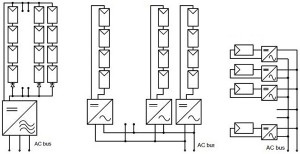Microinverters provide an effective solution to solar-energy harvesting by providing power conversion at the individual panel level. The emergence of highly integrated MCUs offers an attractive approach to microinverter design, providing an option that reduces the cost of complexity which limited widespread adoption of microinverters in the past. Today, designers can build highly efficient microinverter designs using available MCUs from semiconductor manufacturers including Freescale Semiconductor, Infineon Technologies, Microchip Technology, Spansion, and Texas Instruments, among others.
Solar-energy-harvesting systems have continued to evolve away from traditional centralized solutions (Figure 1). Unlike systems based on a single central inverter or even multiple string inverters, microinverters convert power from a single panel. In turn, the AC power generated by microinverters on each panel is combined on the output to the load.
Figure 1: Solar-energy-harvesting methods continue to evolve from central-inverter systems (left) to more distributed string-inverter systems (middle), and finally microinverters (right) built into individual panels. (Courtesy of Freescale Semiconductor)
By generating AC power on each solar panel, the microinverter approach reduces or eliminates costs associated with expensive cabling, cooling, and other facility requirements associated with central- or even string-inverter systems. At the facility level, losses in overall conversion efficiency due to differences in illumination, shading, dirt, or panel age are greatly reduced. Although the use of microinverters increases the cost of an individual panel, the solar installation overall typically has lower costs and higher-conversion efficiency.
Cost-effective solution
For all their apparent advantages, microinverters have been slow to emerge as cost-effective alternatives to traditional inverter systems. In the past, the complex functionality of solar-inverter designs increased the cost of these systems enough to offset the downside of centralized-solar-energy solutions. Indeed, the need to respond to changing environmental conditions to maximize solar-energy conversion requires sophisticated system designs that were difficult to achieve at the cost and effectiveness required for use in individual solar panels.
In an ideal situation, a solar panel produces its maximum power output at a specific point on its IV curve dictated by the characteristics of the environment and the panel itself (Figure 2, left). In practice, this maximum-power point (MPP) can be elusive, shifting to different points on the power curve as shadows pass across the panel from clouds or debris collects on the panel (Figure 2, right). Sophisticated solar-energy systems use maximum-power-point-tracking (MPPT) methods to modify the operating voltage of the panel to ensure that the panel produces its maximum power output despite changing conditions.
For More Details: Integrated MCUs Enable Cost-Effective Microinverters for Solar Energy Designs

